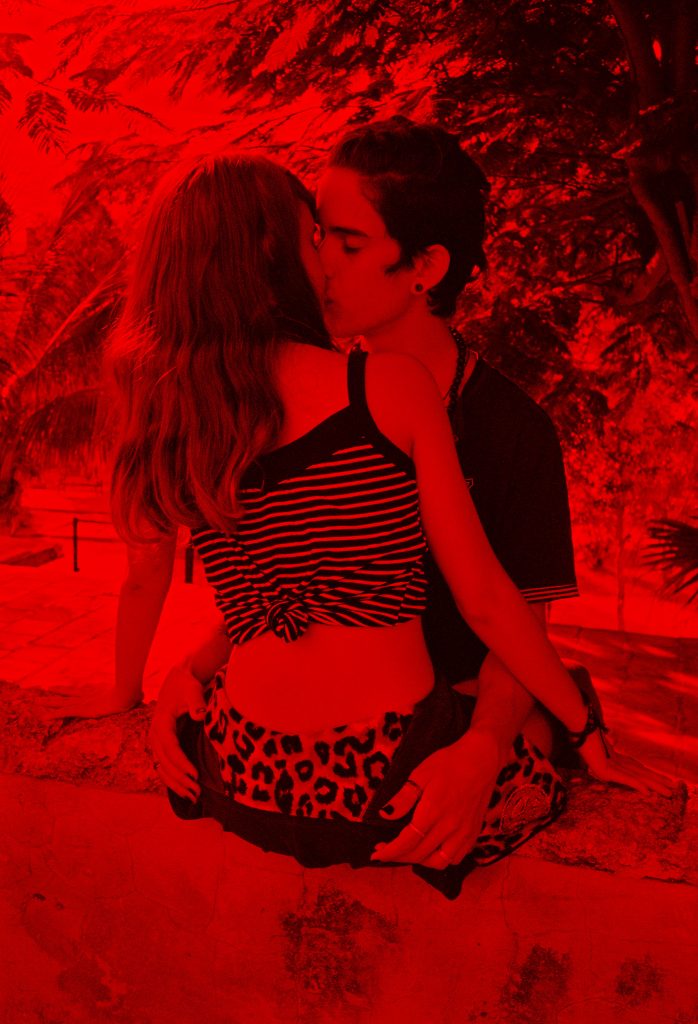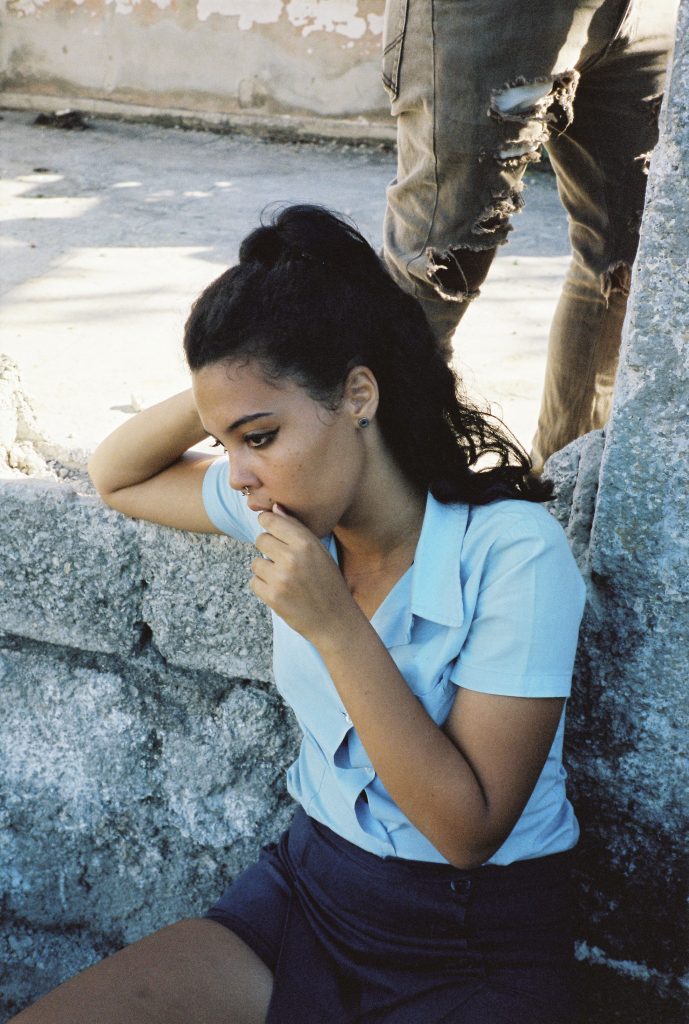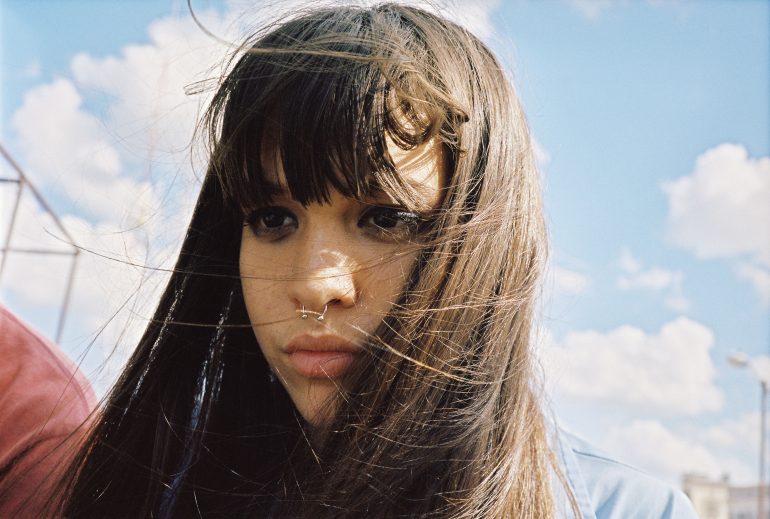by Daniela Mericio
_
I had the pleasure of visiting Champù. The youth of La Vibora, previewed at Photolux Festival, in the company of the author, born in Belgium but in love with Cuba, and of Nanda van den Berg, curator of the exhibition and director of the photography museum Huis Marseille in Amsterdam. Walking through the majestic frescoed halls of the Palazzo Ducale of Lucca, which host the exhibition, I asked them a few questions.
Nanda, how would you define Delbrouck’s work and this one in particular?
I knew his work from some gallery exhibitions in Belgium: it ranged from still life taken in Cuba or in Nepal, to very wild collages. He is a passionate photographer, he paints, he writes, he does everything with a very deep feeling, always with a remarkable flow of images. This, and his books, is the work that I knew. When we agreed to have a meeting, I expected to see the collages, in fact, at first, he unpacked some beautiful collages he made in Cuba. Then he took out a little box and showed me this new work: spontaneous portraits of the young people of Cuba.
Despite living in a difficult country, you can’t find traces of desperation, they are glowing in their youth and in their love for each other. This is what Vincent picked up, and I found it very exciting, I was happy to see this positive glow of hope. I liked the the way he photographed them, as if he was part of the group, even if he was of different age. His view was never voyeuristic or detached, but always in tune with the atmosphere. The story of these young people of Cuba, in one way, is universal; but because of the colours, the sensitivity and engagement of the author, it becomes unique. On this point, I give the floor to the photographer…

Vincent, you have always been fascinated by Cuba, but this project has developed a little bit by chance… how did it all start?
I worked a lot in Havana. I started at the end of the Nineties and I made the first book in 2008, in another neighbourhood of the city, near the Malecón, which is quite tough and intense. Then I left Cuba for years. I had to, because all my work always takes an emotional toll. I wouldn’t say it is autobiographical, but it is related to what I find and the flow of my personal life. When I came back, in 2014, after all those years, I didn’t want to make a documentary about Cuban people, but just see what I could do differently in Cuba. I also went to the suburbs and I met many people. Finally, I found an old friend. He was living in the outskirts of Havana. I went to his place and I slowly fell in love with the neighbourhood, which was a quiet, middle-class area. Cuba is like every country, being still under the Communist regime doesn’t mean you don’t have different levels of life: there are people who have money and others for whom life is hard, especially today that the economic situation is very difficult.
One day, in March 2018, I walked through the neighbourhood with a very nice old lady. She picked up flowers and I took photos of her with flowers in her hair. Then we arrived at the park, at the top of the hill, we met some girls and they asked me to take pictures of them. After one hour I was feeling that I had arrived at the right place. Unconsciously, I knew that I was searching for that: to be with a group of people again and share something intense. So I started to spend time with them.
How long did it take you to complete the work?
A little more than one year: 3 trips of one month each. I stayed with this group of young people, we went to the beach together. Some of them are still finishing school, whereas others are older and just want to meet girls or be together. They have nothing to do, they don’t work, in some cases they are waiting to enter university. These stories are so important to me because they are connected with that very sensitive part of the population, with a strange, high potential and I’m quite sure that they go to the park, because there they can be together and meet people like them. It’s like they need that space, because the “normal” society, or school, it’s different. They listen to music, to rap music – like my son – they create this kind of family, they drink a diluted rum, called champù, they smoke a lot of cigarettes.

Are you still in touch with them? Will you go back again?
Yes, we are even friends on Facebook. Some of them went to Mexico, to the US, others are in Havana. They are never cold, they always say they hope to see me again. They still make me feel part of the family. I will go back in January and maybe make more videos, because I don’t know if I will go there again. Also, last time I went to the park it was empty, so I made some still lifes. But I wouldn’t go if the energy wasn’t there anymore.
This work looks different from the previous ones. What place does it have in your career?
I dare say I see these series as “the series of my life”. I know that I reached exactly what I wanted, I just feel the emotion, in my body. It’s about love and feelings, it’s fundamental. I was always driven towards that age, maybe also because I started the relationship with my girlfriend when I was eighteen. In that period, I always went to the cinema, I wanted to be a director, and I have an image in my mind of a child woman. I remember I loved the movie Nikita by Luc Besson, with the girl behaving crazy sometimes… it’s not about the idea of a Lolita, nothing sexual here, it’s something very pure, the fascination for an age where everything seems possible. It’s not that I’m having a midlife crisis and I want to go back to that, it’s just that I am still that kind of guy, that today is 44, but still a boy of 18 at heart. My son is 17 and I have a connection with him, which is more powerful today than when he was 10. With these teen-agers it’s the same, they are people I trust. Last year in Havana I ended some relationships because I couldn’t trust them completely, maybe because I was a foreigner and they wanted something else. With them it was never like this, they considered me a part of their family. I took pictures, we played together, and all was fine, very nice.
These images communicate joy, energy, love for life but I sometimes see a vein of melancholy. Is it true? Does it also depend on the context?
Yes, it is true. It is typical of that age, because you don’t know exactly what you want and, in that country, there is not much hope, today more than ever and even for older people. The only opportunity for them is to leave home. They love to be there, with their friends, they love Havana and Cuba, but if you ask them if they want to go to Europe, they will all immediately say yes.

Some portraits are amazing; on which aspects did you concentrate more?
There is a kind of cute energy that I love, and also the small gestures, like the continuous fidgeting with the hair. When I make a portrait, I am always attracted to the details, to the way people dress. In fact, here these young people are all very fashionable, but not to seduce you or to pose…they are just like that. Each of them tries to show their different personality through fashion. In the photo of Gabriela, she wears the school uniform: in Cuba, girls have their uniform customized, nobody would go to school with their uniform as they received it from the State. Even if a girl is bigger, for example, she will ask to have it tight. All those details, a little bit of make-up… it’s nice, because in that work you can see the youth of today. We are in a world where young people are attracted to fashion and they know how to use it. In Cuba you can feel it very strongly, it’s not just the American style, it’s the style of today, where you try to find that cool fashion feeling or you listen to that cool kind of music.
Your collages are famous, in these series you didn’t use this technique, are you going to work with it again?
I have a new book out made just of collages. If I consider the book of today and the one of next year, I would say the two paths are separated, they are two parallel ways to express myself. It may seem a contradiction, but we are complete only when we accept our contradictions. Even if people don’t like that.
VINCENT DELBROUCK | CHAMPÙ. THE YOUTH OF LA VIBORA
curated by Nanda van den Berg and Vincent Delbrouck
in cooperation with Huis Marseille and Stieglitz 19
Palazzo Ducale
Cortile degli Svizzeri, 1, Lucca
PHOTOLUX FESTIVAL | 16 November – 8 December 2019
from Monday to Friday: 3–7PM
Saturday and Sunday: 10AM–7:30PM
The Champù series will be on show at Huis Marseille, Amsterdam
from September 5th to December 6th, 2020.
November 30, 2019




